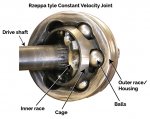- 1,814
- 1,523
- 113
- Location
- Orlando, FL
1. While the kit seems like a good idea, the "fix" is to have the driveshafts rebalanced/repaired, so unless the kit contained extra driveshafts you would likely fix the symptoms (e.g. alternator bolts, water pump stuff) and then break it again another half hour down the road.A few points:
1. If someone put together an "emergency" kit that included: Alt L bracket, Alt Bolts, Alt belt, Water Pump, Water pump belt, Water pump seals, Easy out, drill bit, Loctite. I would certainly buy one. Anything else that would be required to make sure you can sort out this alternator problem the first time you notice it's loose. Sounds like potentially a U as well.
2. I've read a few trucks have the fan blades go through the radiator. Would be be possible to fab a metal(steel) shield to protect the radiator from the fan?
3. Towing services. Could we put together a guide on how to get the LMTV towed and expected prices (general ideas). I personally have no idea who to contact if I break down somewhere.
4. Find a scientific way to measure the driveline vibration to meter and predict when it's doing damage?
5. Write a PMCS guide for which bolts and things to check regarding this vibration issue? I think it's in a few threads but summarizing it would be great. I've already lost the top alternator bolt twice. Fortunately they are cheap and common.
2. Sure, pretty easy to do. Just get some expanded metal grate and make a piece that lays against the rear face of the radiator.
3. Towing these things isn't as tricky as it seems. Heavy duty towing services are everywhere, since big trucks that need recovery are everywhere. Many even offer roadside repair, including stuff like making hydraulic hoses right from the repair truck, because they are typically coming to rescue a commercial truck that is down, and the company is losing money every minute it's not driving. Also for that reason, it's pricey. Getting an FMTV towed is about $300 just for them to respond and pull the driveshaft, and then some number of dollars per mile, so get your wallet out.
4. The scientific ways to measure it are pretty straightforward, and detailed in the engineering reports the government commissioned to figure out why they were destroying drivelines. It's not really something you can just drive around with the instrumentation attached though. I think the bottom line of the story is that if you are driving along and the waterpump or alternator break, STOP, pull the driveshafts and have them balanced/straightened/repaired and/or replace the u-joints.
5. It's on my list of things to do for my "common problems" document, I just haven't got around to it yet. My guess at the sequence of events is that the driveshaft starts to experience vibration (e.g. unbalance, "hinging", wear, etc.), that vibrates the bolts out of the caps of the u-joints (because the military never seems to put the safety tab plates on, or Loctite on the bolts), this amplifies the vibration in a huge way, the amplified vibration shakes the engine significantly, stuff starts breaking on the engine (e.g. cracking water pumps, vibrating bolts out of waterpump or alternator which lets it really shake around and beat itself to death, breaking off fans and starters, breaking transmission cooler lines, etc.). If you're already losing bolts out of the alternator, my suspicion is that you're already on the path. It's probably good to take all the alternator and water pump bolts out, clean them, and [blue] Loctite them, though on the other hand they really shouldn't be vibrating out under normal conditions so maybe it's better to just leave them since they are early warning indicators? I could understand the logic of either argument (mine are currently Loctited).
Last edited:


